Optics and Photonics Journal
Vol.3 No.1(2013), Article ID:28939,12 pages DOI:10.4236/opj.2013.31009
Diode Pumped High Peak Power Quasi Q-Switched and Passively Q-Switched Nd:YVO4 Lasers at 1064 nm and 532 nm Using Cr:YAG and KTP Crystals
1Townes Laser Institute, CREOL College of Optics and Photonics, University of Central Florida, Orlando, USA
2Laser Photonics Research Group, Engineering Physics Department, Military Technical College, Cairo, Egypt
3Military Technical Institute, Cairo, Egypt
Email: ashraf.alsharif@staff.aast.edu, ashraf.elsherif@creol.ucf.edu
Received November 6, 2012; revised December 7, 2012; accepted December 14, 2012
Keywords: High Power Diode Laser; High Power Nd:YVO4 Laser; Cr:YAG Saturable Absorber Mirror; Passive Q-Switching; KTP Crystal; Self Q-Switching; Special Cooling System
ABSTRACT
Diode end-pumped solid-state lasers have the potential to yield high quality laser beams with high efficiency for laser range finding and warning receiver applications as well as day and night military laser designation systems. In this paper we presents theoretical calculations using Advanced Dynamics Professional LASCAD software and experimental studies for a high power pigtailed fiber diode laser module of 8 W operating at 808 nm with a specially designed high efficiency cooling system, end pumped high-efficiency Nd:YVO4 laser of 3 × 3 × 10 mm rod and overall cavity length of 44 mm. To the best of our knowledge a self Q-switching effects was generated in Nd:YVO4 laser by changing the cavity dimensions and the position of the intracavity KTP crystal at certain regime of operation for the first time, in which the cavity length is reduced to be 30 mm and the distance between Nd:YVO4 rod and KTP crystal is only 1mm. Self Q-switched laser pulse at 532 nm with high peak power of 96 W, pulse width of 88 ns at FWHM and repetition rate of 400 kHz was achieved. Experimental studies of a passive Q-switched Nd:YVO4 laser using Cr:YAG crystal with three different transmissions of 30%, 40% and 70% were investigated. Passive Q-switched laser pulse at 1064 nm and narrow line width of less than 1.5 nm with highest peak power of nearly 18 kW, short pulse width of less than 4 ns at FWHM and higher repetition rate of 45 kHz using Cr:YAG with transmission of 30% was achieved for the first time.
1. Introduction
Three decades of solid-state laser research have contributed to the development of a unique family of powerful photonic tools. Solid-state laser media, such as neodymium-doped crystal, was used in applications like laser fusion, material processing, optical communications, product marking, remote sensing and surgery [1,2]. Optical pumping using a semiconductor laser diode instead of conventional flash lamp provides more efficient, reliable, stable laser output, rigid and compact for different of military applications. In contrast to flash lamp pumping (the conventional method for generating a population inversion in solid-state gain media); excitation using a monochromatic and spatially coherent laser pump source offers lower threshold, higher output efficiency, reduction of thermal loading and improving mode quality. Semiconductor lasers were in their formative years, providing low powers (few mW); they were not competitive with flash lamps, until efficient high power AlGaAs laser diode became available in the mid-1980’s [3,4]. Today, reliable one and two-dimensional laser diode arrays are commercially available with continuous-wave and quasiCW peak powers up to 100 W and 10 kW respectively [5]. Simulation using LASCAD tool package provides complex engineering methods; developed on purpose for ease of operation. Great attention has been paid to high peak power all-solid-state blue-green laser for some applications, such as medical applications, spectroscopy, display, optical data storage, undersea detection and communications and day/night military designation systems. The intracavity frequency doubling of a CW laser-diode-pumped Q-switched Nd-doped solid-state laser is one of the most efficient ways to generate these wavelengths. Furthermore, laser-diode-pumped all solid-state laser device has high efficiency, small volume and compact structure, very convenient for different applications. The green laser achieved by a system includes a lasing crystal Nd:YVO4 followed by a nonlinear KTP crystal used for frequency doubling. The Nd:YVO4 was pumped by a laser diode (LD) at 808 nm and produces a main spectral lasing line at 1064 nm. The KTP crystal doubles the lasing frequency and generates output radiation at 532 nm. Exploring the properties of Nd:YVO4 lasers has become very common in the scientific literature in the last decade [6-8]. One important direction popular was related to Q-switching of Nd:YVO4 and microchip lasers [9-12]. In general, Q-switching is an effect in which pulses of light appear at the output of the laser while continuous pumping is applied. Such an effect is obtained by insertion of time-dependent losses into the cavity or by varying the transmission coefficient of the mirrors, which can be done in active manner of the electro-optical modulators or passively. Usually, passive Qswitching includes insertion of an additional crystal into the resonator. Such a crystal is called a saturable absorber mirrors. In this paper, a self Q-switching without the insertion of such a crystal is investigated. In our case, the YVO4 acts not only as the lasing substrate but also as the saturable absorber. The experimental work showed that when the YVO4 crystal is pumped at its edges, slowrate temporal modulation appears at the output of the laser signal. The extinction ratio of this modulation is temperature dependent. Recently, Cr:YAG used as passive Q-switch has received much attention [13]. Cr:YAG, which demonstrates saturable absorption property in the wavelength range of 0.9 - 1.2 µm, has the advantages of large absorption cross section, moderate excited-state lifetime, high doped-ion concentration, good thermal conductivity, high damage threshold, and low saturation intensity, no degradation with time, durability, and stable physical and chemical properties. So it is considered to be an ideal saturable absorber as passive Q-switch element for Nd-doped lasers to obtain high peak power and high repetition rate pulses. Lamp and LD pumped Qswitched lasers with Cr:YAG has been successfully demonstrated for Nd: YAG; Nd: YLF and Nd:S-FAP [14, 15].
2. Experimental Set-Up and Optimizing (DEPSS) CW Nd:YVO4 Laser System
Software simulation was carried out assuming the following parameters; the end pumping configuration as a design scheme using Nd:YVO4 (a-Cut) crystal as a solid state active medium has (1%) doping percentage with different dimensions and a plano-concave resonator will be presented. The Nd:YVO4 crystal was pumped by a high power fiber coupled diode laser module at 808 nm with a maximum output power of 7.8 Watt. The pumped beam focused onto the laser crystal as shown in Figure 1
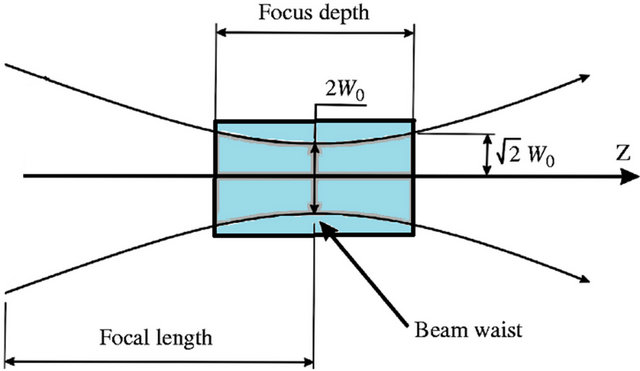
Figure 1. Focusing pumped beam through the crystal.
with a beam waist spot size of 150 µm (which is the radius where the intensity drops to 1/e2 of its value).
The crystal was Anti-Reflection (AR) coated on the pumping side for both absorbed and lasing wavelengths of 808 nm and 1064 nm, respectively. The cavity composed of two mirrors, the input mirror (M1) was coated at the input facet end of the rod, which is Highly-reflection (HR) at 1064 nm and Highly Transmission (HT) at 808 nm. The output coupler was a concave mirror (M2) with radius of curvature of 100 mm, HR at 808 nm with 15% transmission factor at 1064 nm. Figure 2 illustrates the schematic setup of the designed end pumped Nd:YVO4 laser optical resonator.
One of the most important parameter for optimizing laser system design and performing high power laser operation is the interaction between thermal effect and optical system (denoted by the thermal lens of the laser crystal). When a fiber-coupled diode pumped solid state crystal (DPSS) Nd:YVO4 in CW mode of operation, a strong thermal lensing effect with Nd:YVO4. This thermally induced focusing lens drove the laser resonator out of the stable regime. In the absence of laser action; the thermal loading on the medium is strong because of the high heat absorption within the material. Therefore, the thermally induced focusing lens of the material is highest during non-lasing operation [16-21].
Experimental setup for free running diode pumped solid state laser for a cavity length of 44 mm with water cooling system is shown in Figure 3. Pumping a Nd:YVO4 of 3 × 3 × 10 mm rod dimensions by a 808 nm high power diode laser focused into the rod using a special focusing system of 1:1 imaging ratio, a simple water cooling system was used for preventing the thermal lensing through rod. Input mirror was coated at one end of the Nd:YVO4 rod, the output coupler was concave mirror with radius of curvature of 100 mm and partially reflection coated with 85% at 1064 nm.
Figure 4 shows the simulation results at 44 mm (higher slope efficiency and output power) cavity length for DEPSS Laser. The DEPSS laser at cavity length of 44 mm give the highest slope efficiency of 51.6% and effi-

Figure 2. Schematic diagram of the (DEPSS) Nd:YVO4 laser.
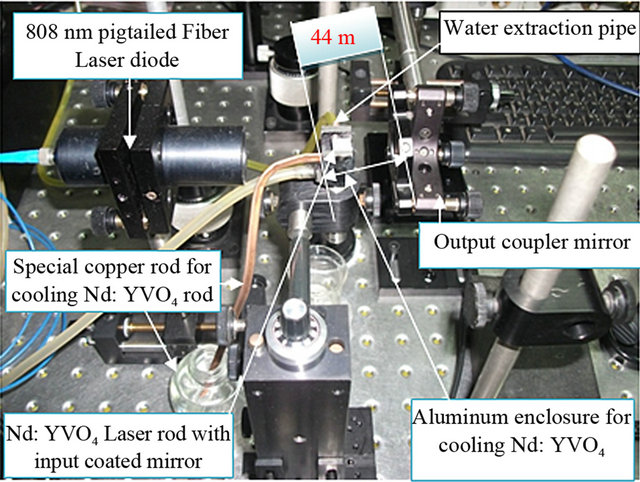
Figure 3. Experimental setup of the DEPSS (Nd:YVO4) laser with cooling system.
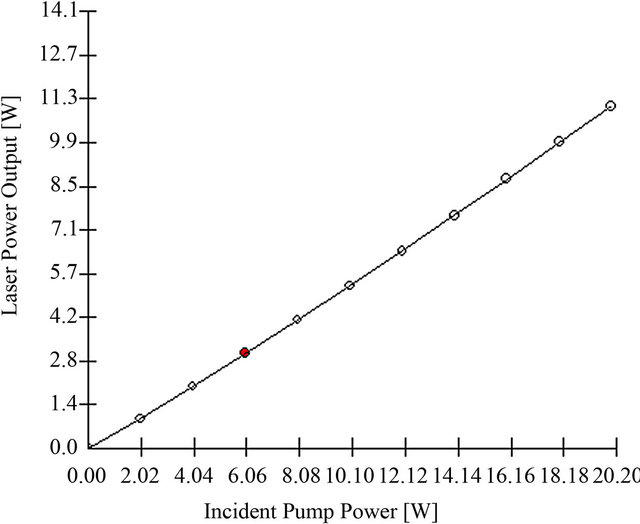
Figure 4. Output optical power versus input optical power of a plano-concave cavity length of 44 mm with −100 mm radius of output mirror.
ciency at incident power of 8 W at 808 nm and output power of 4.1 W at 1064 nm.
3. Wavelength Characteristics of DEPSS (Nd:YVO4) Laser
3.1. Experimental Wavelength Measuring
Figure 5 shows the experimental setup for measuring the
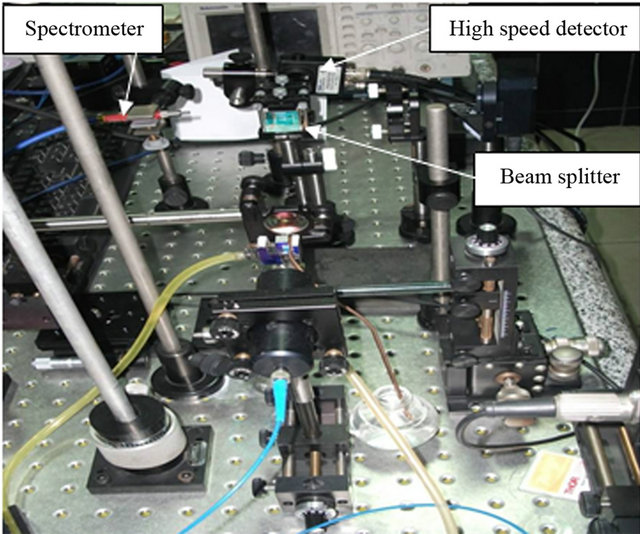
Figure 5. Experimental setup of measuring extracted DEPSS (Nd:YVO4) wavelength.
extracted DEPSS (Nd:YVO4) wavelength characteristics. The high resolution Spectrometer (HR4000CG-Ocean Optics) and “Spectra Suite” interfaced computer software were used to measure the DEPSS extracted laser wavelength exactly at 1064 nm with a precise measured line width at FWHM of 1.48 nm as in Figure 6.
Also, the diagram shows some of the remaining pumped diode laser wavelength at 808 nm before suppresses it with using a band pass optical filter.
3.2. DEPSS Extracted Wavelength Measurements at Different Diode Laser Temperatures
Measuring the extracted output wavelengths at 1064 nm from DPESS laser system with different temperatures (12˚C, 25˚C, 36˚C) [22] are shown in Figure 7, which illustrates the effect of changing diode operating temperature on the DEPSS (Nd:YVO4) output laser wavelength. All measured data were performed at a constant diode input current of 2500 mA, and it’s not necessary to be pumped with constant power. A stabilization of high power output laser wavelength centered at 1064 nm could be achieved at different temperatures of (12˚C, 25˚C, 30˚C) with the use of our proper cooling system with feedback technique as shown in Figure 7. Due to this

Figure 6. The “Spectra Suite” scope page with the pumped and extracted wavelengths.

Figure 7. Effect of changing diode operating temperature on the extracted DEPSS (Nd:YVO4) laser wavelength.
new technique of thermal stabilization there is no wavelength shift is noticed as in our previous attempts [21].
3.3. DEPSS Extracted Wavelength Measurements at Different Pumped Power
Figure 8 illustrates the extracted wavelength measurements at different diode pumped powers of 1 to 6 W with step of 0.5 W at constant temperature of 25˚C. It can be noticed that, stable and sharp wavelength extracted at 1064 nm with less than 1.5 nm line width at FWHM.
3.4. The Output Power Measurements
Using the diode current driver to increase the input electrical current applied to the 808 nm high power diode laser module; which is in linear relation with increasing DEPSS input optical power as shown in Figure 9 [23], which will lead to measure the optical output power response at 1064 nm according to that driving current change. These output measurements were being averaged to 5 readings and measured at a constant diode temperature of 25˚C. Figure 10 shows the DEPSS (Nd:YVO4)
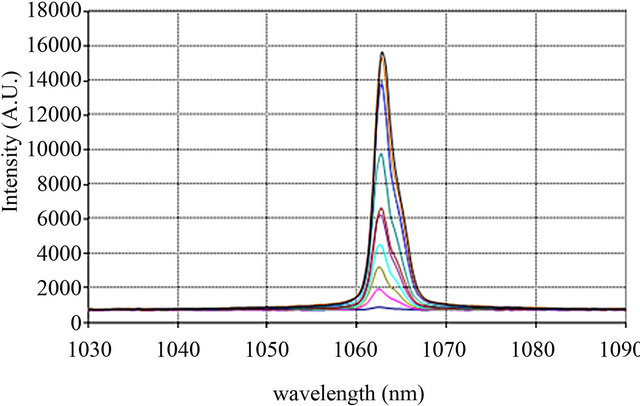
Figure 8. Extracted wavelength measurements at different diode pumped powers.
optical output laser power versus optical pumped laser with an output coupler of 85% reflectivity at 1064 nm.
Figure 10 is a good measuring result for a designed DEPSS (Nd:YVO4) laser at 1064 nm with good cooling system compared to the simulated one shown in Figure 4, the optical to optical slope efficiency of almost 76% and the final conversion efficiency of 60% was investigated. The extracted output laser average power of nearly 4 W at 1064 nm (only Nd:YVO4 laser using pump-reject filter) at incident laser pump power of nearly 6 W at 808 nm.
We can notice that; there were neither output laser power nor slope efficiency saturated or decreased and the relation was purely linear; which lead to the ability of extracted much more continuous higher efficient laser power at 1064 nm if there exist higher pumped power without decreasing in optical slope efficiency of 76% with threshold pumping laser power of less than 810 mw.
3.5. DEPSS (Nd:YVO4) Output Laser Beam Shape
The most DEPSS (Nd:YVO4) laser attractive feature is the fundamental TEM00 mode shape, which can be measured using IR thermal imager (Fluke Ti32) to analyze the output laser beam quality with confirmation of the output laser beam temperature gradient. Figure 11(a) illustrates the 2D measured fundamental TEM00 mode shape and shows the pure Gaussian distribution of the output laser beam at 1064 nm, Figure 11(b) illustrates the 3D beam profile for the output laser beam using IR (CCD) beam profiler (Coherent Inc.).
3.6. High Power 532 nm Green Laser Using (Nd:YVO4/KTP) Laser System
KTiOPO4 (KTP) crystal is an excellent nonlinear optical material and has been extensively used in frequency doubling of IR lasers. It has a lot of excellent properties such as high nonlinear optical coefficient (about 15 times
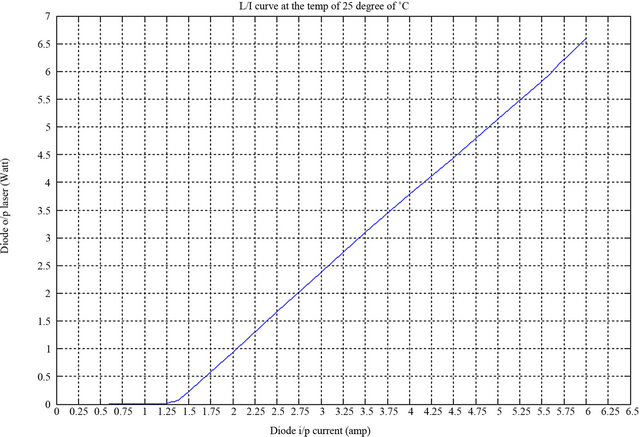
Figure 9. Measured optical characteristics (L-I) curve of the high power diode laser operating at temperature of 25˚C.
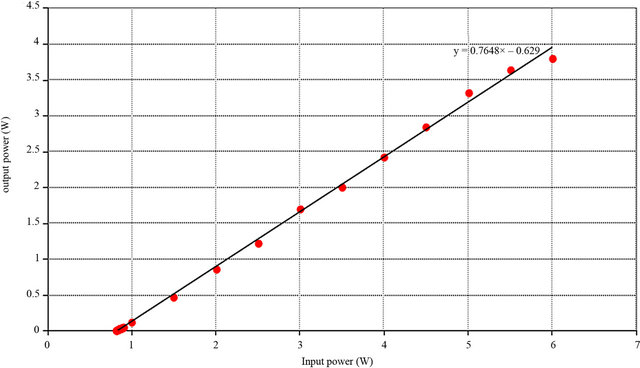
Figure 10. DEPSS (Nd:YVO4) optical output laser power versus optical pumped one.
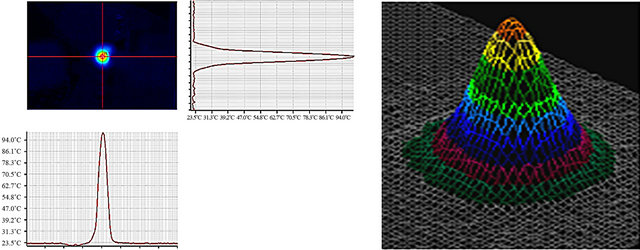 (a) (b)
(a) (b)
Figure 11. (a) The fundamental (TEM00) mode measured by Fluke Ti32 thermal imager; (b) The 3D beam profiler by using IR (CCD camera) for a CW DEPSS Nd:YVO4 laser.
KDP crystal), high Electro-Optic coefficient, low dielectric constant, high thermal conductivity (2 times that of BNN crystal). It is useful for making green laser which used in many different applications like LIDAR, medical applications, detection and communication under water [24-31].
3.7. Experimental Setup of (Nd:YVO4/KTP) Laser System
KTP was inserted inside the DEPSS laser cavity with the same dimensions and optical parameters. KTP crystal dimension was 5 × 5 × 8 mm with cutting angle θ = 90˚, ϕ = 23.5˚ with two faces S1, S2 of anti-reflection coating at 1064 nm and 532 nm. The crystal adjusted in a certain position inside the Plano-concave resonator, the extracted output laser average power of 3.38 W at 532 nm (only green laser using pump-reject filter) at incident laser pump power of 6 W at 808 nm.
The high resolution spectrometer (HR4000CG-Ocean Optics) and “Spectra Suite” computer software were used to measure the DEPSS extracted output laser wavelength. Figure 12 shows the measured DEPSS (Nd:YVO4) output laser wavelength of 532 nm, and some of the remaining input laser wavelength at 1064 nm for the DEPSS (Nd:YVO4/KTP) laser system before we suppress it using optical band-pass filter. There is no evidence of any of the main high power diode laser pumping power at 808 nm.
3.8. Extracted Wavelength Measuring at Different Pumped Power
Figure 13 shows the extracted wavelength measuring at different diode pumped powers of 1 W to 6 W with step of 1 W and at constant temperature of 25˚C, which illus-
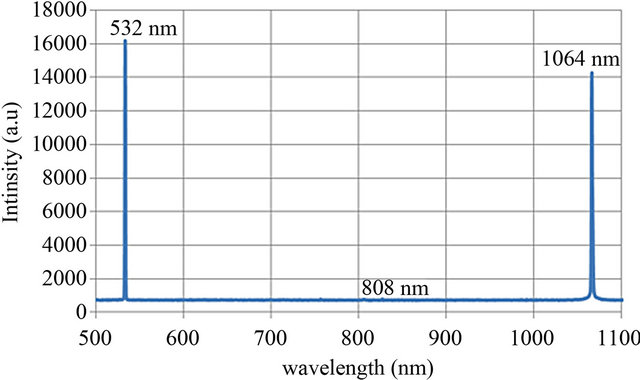
Figure 12. Input and extracted wavelengths for the (Nd: YVO4/KTP) laser system are viewed.
trated that a highly stabilized wavelength extracted at exactly 532.8 nm (measured at FWHM) for any of these pumping regimes (with spectrometer calibration error of <1 nm at this band of wavelength). It was noticed that the DEPSS extracted output laser wavelength was independent of either diode increasing pumped power or diode driving current temperature changing; as it produced a final sharp and stable output laser wavelength. Figure 13 was a measuring result for a designed DEPSS (Nd: YVO4/KTP) laser at around 532 nm by using a good cooling system.
Figure 14 illustrate that the optical to optical slope efficiency to be around 66% and the final conversion efficiency to be 56%. Figure 14, shows that, there were neither output laser power nor slope efficiency saturated or decreased and the relation was purely linear; which lead to the ability of extracted much more continuous higher efficient laser power at 532 nm if there exist higher pumped power without decreasing in optical slope efficiency of 66% with threshold pumping laser power of
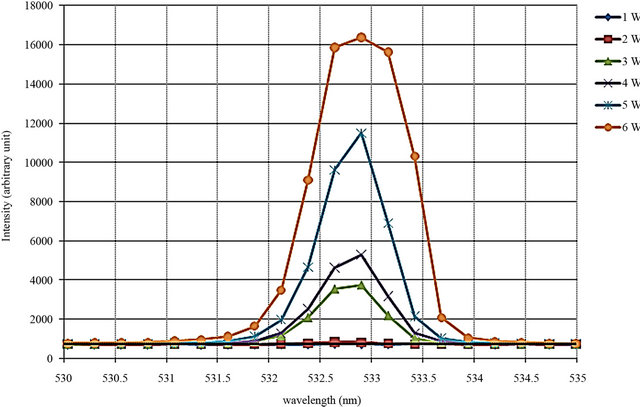
Figure 13. The DEPSS extracted wavelength at different diode pumped powers.
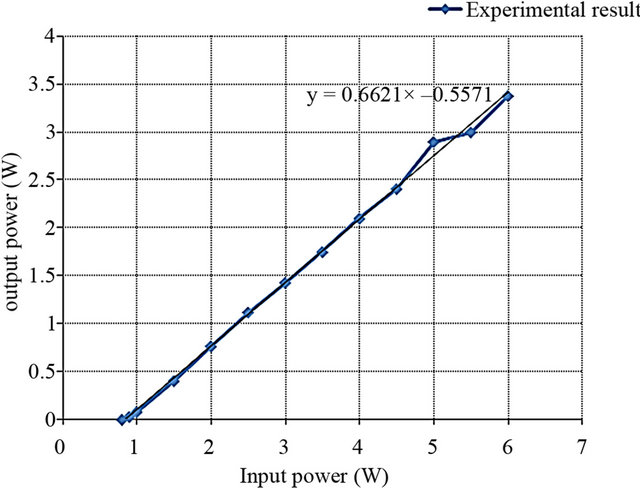
Figure 14. DEPSS (Nd:YVO4/KTP) optical output power versus optical pumped one.
less than 810 mw.
3.9. Experimental Investigation of the Self Q-Switching Effects
Experimentally by very fine alignments and changing the dimensions of the cavity systems (Nd:YVO4/KTP/output coupler) and measuring the output laser signal by using avalanche photo detector (APD), the photograph of the experimental setup is shown in Figure 15. The cavity length became 30 mm and the distance between Nd:

Figure 15. Cavity at new dimension with new alignment.
YVO4 and KTP crystal was 1 mm. The output wavelength was nearly 533 nm, the cavity dimension was modeled by LASCAD software and it was stable. This laser signals were achieved at a proper spatial position of certain pumping regime (close to the corner of the crystal), and temporal fluctuations or pulse trace were measured.
Figure 16(a) illustrates the generated self Q-switched pulses with shortest pulse width of 88 ns (FWHM) at 400 kHz repitation rate and optical pulse to pulse stability of better than 60%, the average power of 3.38 W and highest peak power of 96 W were investigated. The YVO4 atoms in this case were used not only to allow the lasing process but also as the saturable absorber [32]. Figure 15(b) presents the continuous output lasing when the pumping beam is shifted to a different spatial position through the KTP crystal, that does not initiate the self Q-switching effect, and it quickly readout continuous and stable laser signal at 532 nm as seen in Figure 16(c). The experimental output laser power versus input 808 nm input laser power was as shown in Figures 17(a) and (b) as well as the beam profile at the highest average and peak power.
4. Experimental Investigation for Different Cr:YAG Crystals with Different Initial Transmission
Using CW mode of operation for the laser diode of 6 W at 808 nm as a pumping source for 1% Nd:YVO4 rod, and Cr:YAG crystal was placed intracavity as a passive Q-switching element. Using three Cr:YAG crystals with different initial transmission of 30%, 40% and 70%. High power diode laser module was a continuous GaAlAs quantum-well laser diode with a maximum power of 6 W. The length of the cavity was 4.4 mm, output coupler reflectivity of 85%. Q-switched pulsed laser at 1064 nm with narrow pulse width and high peak power were achieved. Figures 18(a) and (b) show experimental set up and photograph for the Nd:YVO4/Cr:YAG laser system. Passive Q-switched laser at 1064 nm with an average power of ranges from 0.5 W to 3.25 W using Cr:YAG [11,14-16] initial transmission of 30% as in Figure 19, pulse repetition rate ranges from 45 kHz to 400 kHz. Figure 20(a), pulse width ranges from the shortest one of 4 ns to the largest pulse width of 250 ns at FWHM using initial transmission of 40% and 70%, and increased to 310 ns with 30% respectively at lower pump power of 2 W, as seen in Figure 20(b) and peak power at certain mode of operation for limited pump power ranges from 13 kW to 18 kW using 70% and 30%, respectively were investigated and measured.
 (a) (b) (c)
(a) (b) (c)
Figure 16. Self Q-switching of Nd:YVO4 (a) The output of the crystal with continuous pumping; (b) The output after fine adjustment and (c) The stable output without Q-switching.
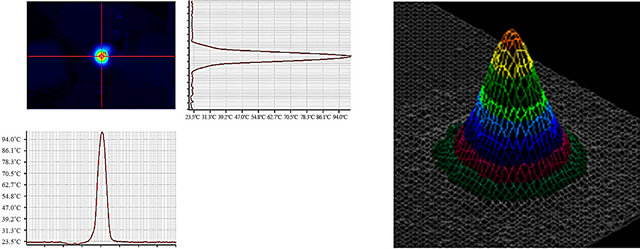 (a) (b)
(a) (b)
Figure 17. (a) Fundamental (TEM00) mode measured by Fluke Ti20 (thermal imager); and (b) The 3D beam profiler by using (CCD camera) for DEPSS (Nd:YVO4/KTP) laser.
 (a)
(a)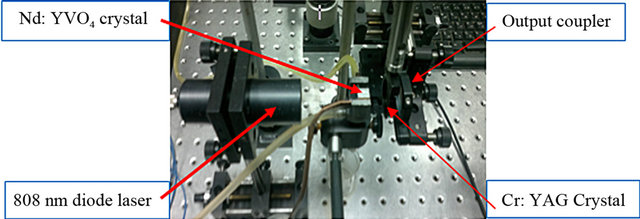 (b)
(b)
Figure 18. (a) The experimental setup of Cr:YAG passive Q-switched Nd:YVO4 at 1064 nm laser; (b) Photograph of Cr:YAG passive Q-switched Nd:YVO4 at 1064 nm laser.
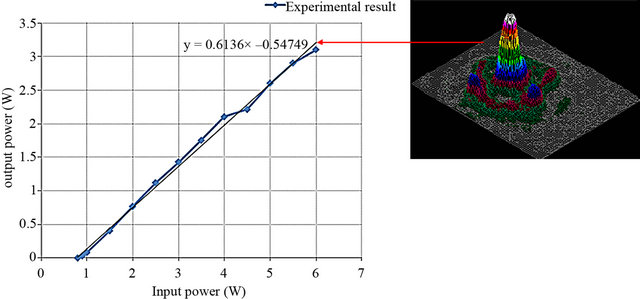
Figure 19. DEPSS (Nd:YVO4/Cr:YAG) optical output power versus optical pumped one and mode shape at its highest average power.
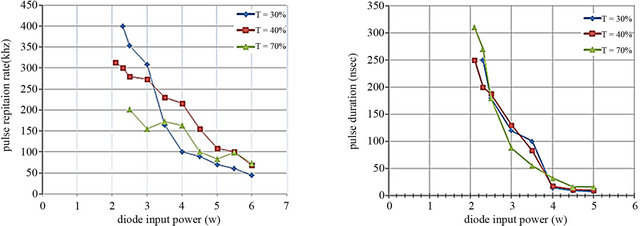 (a) (b)
(a) (b)
Figure 20. Parameters of passive Q-switched 1064 nm laser of (a) Repetition rate; (b) Pulse width as a function of incident pump power.
The time characteristics of the highest and fast passive Q-switched laser pulses were measured with the help of a fast vacuum photodiode (Thorlab Inc. model PDA10C) and Tektronix oscilloscope TDS 3052B (200 MHz, 2 GS/s). Using a CCD beam profiler camera (Coherent model) and spectrometer (HC4000-Ocean Optics model) from ocean optics and a power and energy meter (Genetic-solo 2 model). The highest performance output waveforms and pulses trace of the produced peak power laser signal of 13 kW with pulse width less than 25 ns.
Figure 21(a) at repetition rate of 10 kHz and pulse to pulse stability of more than 93% with initial transmission of 70% was achieved and measured using fast and amplified photodetector and can be shown in the following Figure 21(b). The highest peak power of 18.03 kW laser signal at repetition rates of 45 kHz and shortest pulse width of 4 ns was achieved. It is found that the Cr:YAG passive Q-switch with initial transmission of 30% had the highest average power of 3.25 W, highest repetition rates and best beam profile shape.
Figures 22(a) and (b) shows the 2D and 3D beam profile of a passive Q-switched DEPSS Nd:YVO4 using Cr:YAG crystal.
5. Conclusions and Discussions
This achievement was a result of optimizing optical parameter of the Nd:YVO4 rod through coated the input mirror on the undoped end of the rod to reduce thermal lensing. Also using multi axis alignment system in addition to a good cooling system facilitated the experimental work and contributed in achieving better parameters and enhanced the performance of the passive Q-switched DEPSS laser operation. A kind of a self-pulsating DEPSS laser was established with only the Nd:YVO4 rod with KTP as nonlinear crystal with small changes in cavity dimensions and KTP alignment.
This phenomenon is considered as a type of passive Q-switching techniques at wavelength of 532 nm in the visible band, which is very useful as using the same unit
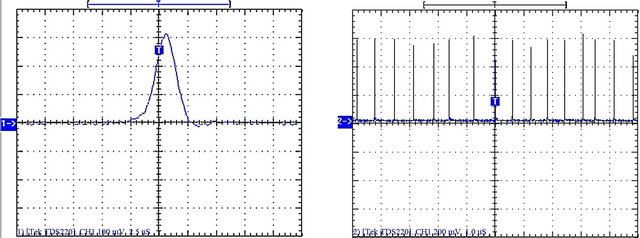 (a) (b)
(a) (b)
Figure 21. (a) Pulse width of less than 25 ns at FWHM; (b) Pulse trace at repetition rate of ≈10 kHz with pulse to pulse stability of more than 90%.
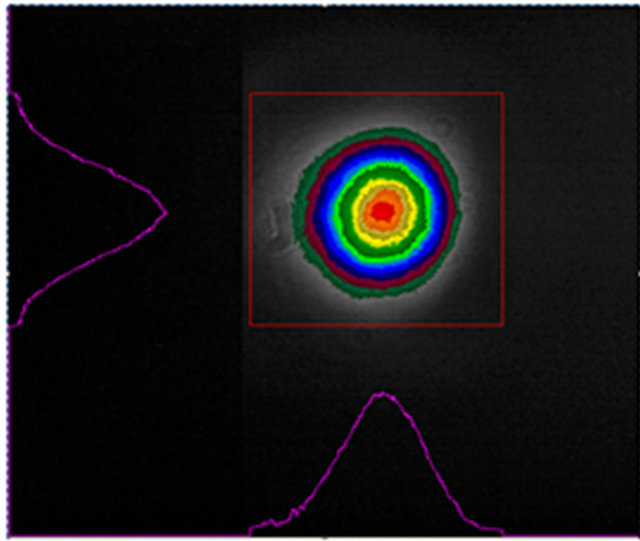 (a)
(a) (b)
(b)
Figure 22. Cr:YAG Q-switched at initial transmission of 70% output at 3.25 W average output power (a) Two dimension of beam profile; (b) Three dimension laser beam profile.
with certain optomechinal mechanism to place a KTP crystal intracavity instead of Cr:YAG, and it will be our next research work. Experimental studies using three different Cr:YAG crystals at three initial transmissions of 30%, 40% and 70%, a highest peak power of 18 kW, shortest pulse width of 4 ns with transmission of 30%, and highest repetition rate of 45 kHz was investigated. The best beam profile and pulse to pulse stability of highest peak power of 13 kW, pulse width of 25 ns at FWHM, and repetition rate of 10 kHz with 70% initial transmission was achieved. The advantages of this passive Q-switch system is to compress and compact the device size and make a good pulse to pulse stability at certain frequency which also can be changed only with the change of input pump power only or change of the initial transmission of the Cr:YAG crystal, which can be used in day/night laser pointing, marking and designation military systems.
REFERENCES
- J. M. Yang, J. Liu and J. L. He, “Efficient Diode-Pumped Nd:YVO4 Continuous-Wave Laser at 1. 34 mm,” Optics, Vol. 115, No. 12, 2004, pp. 538-540. doi:10.1078/0030-4026-00538
- H. R. Zhang, M. J. Chao, M. Y. Gao, L. W. Zhang and J. Q. Yao, “High Power Diode Single-End-Pumped Nd: YVO4 Laser,” Optics & Laser Technology, Vol. 35, No. 6, 2003, pp. 445-449. doi:10.1016/S0030-3992(03)00051-3
- G. P. Agrwal, “Semiconductor Lasers,” 2nd Edition, Van Nostrand Reinhold, New York, 1993.
- W. Streifer, D. R. Scifres, G. L. Hrnagel, D. F. Welch, J. Berger and M. Sakamoto, “Advances in Diode Laser Pumps,” IEEE Journal of Quantum Electronics, Vol. 24, No. 6, 1988, pp. 883-894.
- D. F. Welch, “A Brief History of High-Power Semiconductor Lasers,” IEEE Journal of Quantum Electronics, Vol. 6, No. 6, 2000, pp. 1470-1477.
- D. Jaque, J. J. Romero, Y. Huang and Z. D. Luo, “Tunable Green Laser Source Based on Frequency Mixing of Pump and Laser Radiation from a Nd:YVO4 Crystal Operating at 1342 nm with an Intracavity KTP Crystal,” Applied Optics, Vol. 41, No. 30, 2002, pp. 6394-6398. doi:10.1364/AO.41.006394
- J. E. Bernard, V. D. Lokhnygin and A. J. Alcock, “Grating-Tuned, Single-Longitudinal-Mode, Diode Pumped Nd:YVO4 Laser,” Optics Letters, Vol. 18, No. 23, 1993, pp. 2020-2023. doi:10.1364/OL.18.002020
- Y. F. Chen, “Efficient Subnanosecond Diode-Pumped Passively Q-Switched Nd:YVO4 Self-Stimulated Raman Laser,” Optics Letters, Vol. 29, No. 11, 2004, pp. 1251- 1253. doi:10.1364/OL.29.001251
- R. Scheps, J. F. Myers and G. Mizell, “High-Efficiency 1.06 Micrometer Output in a Monolithic Nd:YVO4 Laser,” Applied Optics, Vol. 33, No. 24, 1994, pp. 5546- 5550. doi:10.1364/AO.33.005546
- Y. F. Chen, K. F. Huang, S. W. Tsai, Y. P. Lan, S. C. Wang and J. Chen, “Simultaneous Mode Locking in a Diode-Pumped Passively Q-Switched Nd:YVO4 Laser with a GaAs Saturable Absorber,” Applied Optics, Vol. 40, No. 33, 2001, pp. 6038-6041. doi:10.1364/AO.40.006038
- J. Liu, B. Ozygus, S. Yang, J. Erhard, U. Seelig, A. Ding, H. Weber, X. Meng, L. Zhu, L. Qin, C. Du, X. Xu and Z. Shao, “Efficient Passive Q-Switching Operation of a Diode-Pumped Nd:GdVO4 Laser with a Cr4+:YAG Saturable Absorber,” Journal of the Optical Society of America B, Vol. 20, No. 4, 2003, pp. 652-661. doi:10.1364/JOSAB.20.000652
- J. A. Morris and C. R. Pollock, “Passive Q-Switching of a Diode Pumped Nd:YAG Laser with a Saturable Absorber,” Optics Letters, Vol. 15, No. 8, 1990, pp. 440-442. doi:10.1364/OL.15.000440
- R. S. Conroy, T. Lake, G. J. Friel, A. J. Kemp and B. D. Sinclair, “Self Q-Switched Nd:YVO4 Microchip Laser,” Optics Letters, Vol. 23, No. 6, 1998, pp. 457-459. doi:10.1364/OL.23.000457
- Y. X. Leng, L. H. Lin, Y. B. Ou and X. K. Wan, “Absorption of Excited State of Cr:YAG Crystal,” Acta Optica Sinica, Vol. 21, No. 2, 2001, pp. 225-227.
- Y. Shimony, Z. Burshtein and B. A. Ben-Amar, “Repetitive Q-Switching of a CW Nd:YAG Laser Using Cr:YAG Saturable Absorber,” IEEE Journal of Quantum Electronics, Vol. 32, No. 2, 1996, pp. 305-310. doi:10.1109/3.481878
- X. Zhang, S. Zhao and Q. Wang, “Laser Diode Pumped Cr:YAG Passively Q-Switched Nd:S-FAP Laser,” Optics Communications, Vol. 155, No. 1-3, 1998, pp. 55-60. doi:10.1016/S0030-4018(98)00356-3
- Z. Ma, D. J. Li, J. C. Gao, N. L. Wu and K. M. Du, “Thermal Effects of the Diode End-Pumped Nd:YVO4 Slab,” Optics Communications, Vol. 275, No. 1, 2007, pp. 179-185. doi:10.1016/j.optcom.2007.03.024
- J. L. Blows, T. Omatu, J. Dawes, H. Pask and M. Tateda, “Heat Generation in Nd:YVO4 with and without Laser Action,” IEEE Photonics Technology Letters, Vol. 10, No. 12, 1998, pp. 1727-1729. doi:10.1109/68.730483
- T. Y. Fan, “Heat Generation in Nd:YAG and Yb:YAG,” IEEE Journal of Quantum Electronics, Vol. 29, No. 6, 1993, pp. 1457-1459. doi:10.1109/3.234394
- Z. Xiong, Z. G. G. Li, N. Moore, W. L. Huang and G. C. Lim, “Detailed Investigation of Thermal Effects in Longitudinally Diode-Pumped Nd:YVO4 Lasers,” IEEE Journal of Quantum Electronics, Vol. 39, No. 8, 2003, pp. 979-986. doi:10.1109/JQE.2003.814371
- W. Koechner, “Solid State Laser Engineering,” 3rd Edition, Spronge-Verlag, Berlin, 1992, pp. 381-413.
- A. M. Samy, A. F. El-Sherif, A. M. Mokhtar and M. F. Hassan, “Simulation and Analysis of a High Power Diode-End-Pumped Nd:YVO4 Solid-State Laser,” Proceedings of 4th International Conference on Engineering Mathematics and Physics, Cairo, May 2008, pp. 231-241.
- A. F. El-Sherif, M. F. Hassan, A. M. Mokhtar and A. M. Samy, “Characterization of a 808 nm High Power Diode Laser Module,” Proceedings of 4th International Conference on Engineering Mathematics and Physics, Cairo, May 2008, pp. 242-251.
- D. Jaque, J. J. Romero, Y. Huang and Z. D. Luo, “Tunable Green Laser Source Based on Frequency Mixing of Pump and Laser Radiation from a Nd:YVO4 Crystal Operating at 1342 nm with an Intracavity KTP Crystal,” Applied Optics, Vol. 41, No. 30, 2002, pp. 6394-6398. doi:10.1364/AO.41.006394
- J. E. Bernard, V. D. Lokhnygin and A. J. Alcock, “Grating-Tuned, Single-Longitudinal-Mode, Diode-Pumped Nd: YVO4 Laser,” Optics Letters, Vol. 18, No. 23, 1993, pp. 2020-2023. doi:10.1364/OL.18.002020
- Y. F. Chen, “Efficient Subnanosecond Diode-Pumped Passively Q-Switched Nd:YVO4 Self-Stimulated Raman Laser,” Optics Letters, Vol. 29, No. 11, 2004, pp. 1251- 1253. doi:10.1364/OL.29.001251
- R. Scheps, J. F. Myers and G. Mizell, “High-Efficiency 1.06-Micrometer Output in a Monolithic Nd:YVO4 Laser,” Applied Optics, Vol. 33, No. 24, 1994, pp. 5546- 5550. doi:10.1364/AO.33.005546
- Y. F. Chen, K. F. Huang, S. W. Tsai, Y. P. Lan, S. C. Wang and J. Chen, “Simultaneous Mode Locking in a Diode-Pumped Passively Q-Switched Nd:YVO4 Laser with a GaAs Saturable Absorber,” Applied Optics, Vol. 40, No. 33, 2001, pp. 6038-604. doi:10.1364/AO.40.006038
- J. Liu, B. Ozygus, S. Yang, J. Erhard, U. Seelig, A. Ding, H. Weber, X. Meng, L. Zhu, L. Qin, C. Du, X. Xu and Z. Shao, “Efficient Passive Q-Switching Operation of a Diode-Pumped Nd:GdVO4 Laser with a Cr4+:YAG Saturable Absorber,” Journal of the Optical Society of America B, Vol. 20, No. 4, 2003, pp. 652-661. doi:10.1364/JOSAB.20.000652
- J. A. Morris and C. R. Pollock, “Passive Q-Switching of a Diode-Pumped Nd:YAG Laser with a Saturable Absorber,” Optics Letters, Vol. 15, No. 8, 1990, pp. 440-442. doi:10.1364/OL.15.000440
- R. S. Conroy, T. Lake, G. J. Friel, A. J. Kemp and B. D. Sinclair, “Self Q-Switched Nd:YVO4 Microchip Laser,” Optics Letters, Vol. 23, No. 6, 1998, pp. 457-459. doi:10.1364/OL.23.000457
- Z. Zalevsky, Y. Kapellner, I. Eyal and N. Cohen, “Self Q-Switching Effect in a Nd:YVO4/KTP Lasing Unit,” Optical Engineering, Vol. 45, No. 7, 2006, Article ID: 070506.

